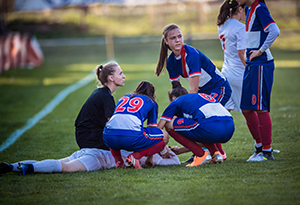Recognizing Internal Injuries in Young Athletes
Recognizing Internal Injuries in Young Athletes
Millions of children and teens in the U.S. participate in organized and recreational sports. These activities have important physical and social benefits, but they are not without risk. According to the CDC, nearly 2.7 million young people are treated in the emergency room every year for sports-related injuries.
If you are the parent of a young athlete, you are probably used to dealing with scrapes, bumps, sprains, and strains. Less common but potentially much more dangerous are internal abdominal injuries from blunt trauma, serious injuries that occur when the body hits or collides with a large object. These types of injuries are most common in contact sports like football, ice hockey, soccer, and lacrosse.
Types of internal abdominal injuries
Sports-related abdominal injuries are rare, but some studies suggest they are increasing. The most common injuries include:
Kidney injury. This may cause flank pain and blood to appear in the urine.
Spleen injury. This causes pain in the upper left side of the abdomen. The spleen filters almost 10% of the body's blood supply every minute. Tearing of the spleen can cause rapid and life-threatening internal bleeding.
Liver injury. This causes pain in upper right side of the abdomen. The liver has two lobes. The lobe most often injured is the right lobe because it is bigger and presses against the ribcage. A torn liver can cause severe bleeding, but it doesn't bleed as frequently as a torn spleen.
Abdominal injury. This can result in injury to the pancreas, diaphragm, stomach, gallbladder, bladder, or intestines. Any organ in the abdomen can be injured. A single organ or multiple organs can be injured.
Recognizing abdominal injuries
Because these injuries can result in rapid blood loss, it's important to recognize them as soon as possible. If you or the team coach, doctor, or trainer suspects this type of injury, your child should be transported to an emergency care facility for evaluation.
These are signs and symptoms to look for:
Abdominal pain
Tenderness over the injured area
Rigid abdomen
Left arm and shoulder pain (spleen)
Right-sided abdominal pain and right shoulder pain (liver)
Blood in the urine (kidney)
Cold, sweaty skin (early signs of shock)
Bluish discoloration of the belly or bruising particularly around the belly button and flanks
Nausea and vomiting
Rapid pulse
Low blood pressure
Loss of consciousness
Diagnosis and treatment of abdominal injuries
When your child has symptoms of abdominal trauma and is being evaluated by emergency caregivers, the most important part of the diagnosis is the pulse and blood pressure. A rapid pulse and falling blood pressure indicate internal bleeding.
This is what may happen next:
If there are signs of internal bleeding, an IV (intravenous) line is inserted and fluids are given to stabilize the blood pressure.
Blood tests may be done to measure blood volume and to prepare for possible blood transfusions.
If blood pressure can't be stabilized, your child will be taken to the operating room for repair of any internal bleeding.
If blood pressure is stabilized, a CT scan with contrast may be done to search for or pinpoint any internal damage. Contrast is a special type of dye that is injected into the bloodstream to make the X-ray images easier to read.
If there is any blood in the urine, a special type of CT scan that includes putting contrast dye into the bladder and kidneys may be done.
Blood tests that look for abnormal liver enzymes in the blood may be done if liver injury is suspected.
If any of the CT scans show significant internal bleeding, surgery will likely be done as soon as possible. If the CT scan shows less severe bleeding especially into the spleen and liver, your child will be monitored very closely and the caregivers will attempt to spare your child from surgery.
If there is no evidence of bleeding, your child may be observed or released.
Blunt abdominal trauma is a rare but potentially serious sports-related injury. If your young athlete participates in a contact sport, take some preventive steps. Make sure that the sport is properly coached and supervised and that a certified athletic trainer is available to evaluate any injuries. The athletic trainer should have an emergency plan in the event of a severe abdominal injury or other serious problem. In addition, protective gear for these sports should meet all safety standards and be worn at all times during contact.
Updated:
February 14, 2018
Sources:
Abdominal injuries and sport. Ryan, John M. Br J Sports Med. 1999;33:155–160., Overview of blunt abdominal trauma in children, Up To Date, Schonfeld, Blunt abdominal trauma in children, Current Opinion in Pediatrics (2012); 24(3); pp. 314-8
Reviewed By:
Fraser, Marianne, MSN, RN,Images Reviewed by Staywell medical art team.,Perez, Eric, MD
